American Bureau Of Shipping
-
- American Bureau Of Shipping— A 'Class Act' For Over 125 Years Maritime Reporter, Feb 1988 #52
the Atlantic Mutual Insurance Company, led a group of New York City marine insurance companies in forming a not-for-profit, benevolent purpose society to promote the safety of life at sea. This evolved into the American Bureau of Shipping which developed the procedure of rating the structural and mechanical fitness of ships called classification.
The promotion of the safety of life and property through classification has remained the central focus of ABS ever since. While this focus is unchanged, the knowledge, experience and resources of ABS have grown. In recognition of this advancement, the activities of ABS have evolved from strictly ship classification into related areas. Today, ABS and its subsidiaries of the ABS Group of Companies, Inc. provide certification, inspection, analysis, quality assurance, and ship classification service to marine, offshore, government and industrial sectors on a worldwide basis.
The first ABS rules, those for Building and Classing Wooden Vessels, were published in 1870.
Since that time, ABS rules have kept pace with the developments in the shipbuilding industry, with Rules for Building and Classing Iron Vessels published in 1877; and Rules for Building and Classing Steel Vessels in 1890. These latter standards have been updated and published annually ever since.
The first half of the 1940s was a time of unprecedented growth for ABS. From the start of World War II through 1945, a total of 5,171 Liberty Ships, Victory Ships, T-2 tankers and various other type vessels were built to ABS classification as part of the Maritime Commission's Wartime Shipbuilding Program.
This set the stage for ABS's emergence as an international organization.
Following the war, ABS representation expanded throughout the world, as the government sold hundreds of ABS class surplus vessels to allies who had lost a large portion of their fleets. Today, ABS has nearly 850 exclusive surveyors and engineers stationed in 168 locations around the world, on call 24- hours-a-day.
The late 1950s and early 1960s marked a significant transition period for ABS and for the shipbuilding industry—a technological transition.
Up until that time, the primary criterion by which a ship could be classed was by comparison with similar ships proven successful in service.
However, advancements in marine design made it evident that a means for analyzing innovative structures was needed.
ABS responded in 1965 by participating with the University of Arizona and Chevron Shipping Company in a research project to develop a finite element system of programs, known as DAISY, for a computeraided analysis of any type of vessel structure.
By the early 1970s, computeraided finite element analysis enabled ABS to class a number of innovative ship types—large selfpropelled LNG carriers, pure container and barge carriers, very large crude carriers, floating industrial units, rigidly integrated tug-barge combinations, and mobile offshore drilling units.
Also, with the innovations of the 1960s, there arose a need for classification standards for application to special purpose vessels whose unique structural or mechanical features were not comprehensively covered by the ABS rules for steel vessels.
Therefore, ABS published guides covering the construction and classification of nuclear ships, underwater systems and vehicles and mobile drilling units. As the years went on, ABS special rules and guides have been published to fit the needs of the marine and offshore industry, and in 1987, its 125th year, ABS published 21 different guides, including the Guide for Building and Classing Offshore Racing Yachts, and 16 different rules.
In 1970, ABS Worldwide Technical Services, Inc. (ABSTECH) was formed as a wholly owned subsidiary of ABS to provide certification, inspection, analysis and quality assurance services to the marine sector for functions above and beyond those traditionally performed and also to related nonclassification services in the industrial sector.
In 1978, ABS commenced classification and certification services with site specific structures of various types including single point moorings, hydrocarbon production and processing structures, floating production storage offloading units, and steel and concrete caisson drilling units and concrete islands.
As the 1970s moved on to the 1980s, ABS activity with all types of vessels continued to increase, but its work with the offshore sector grew the fastest. ABS had been involved with mobile offshore drilling units (MODUs) since their inception in the Gulf of Mexico some 25 years earlier. About two-thirds of the world's MODUs are ABS classed.
Late in 1981 and early 1982, the U.S. Coast Guard signed a two-year Memorandum of Understanding with ABS under the terms which the Coast Guard agreed to accept ABS plan review and inspection of various hull and machinery items for construction of U.S.-flag vessels built to ABS class and USCG certification requirements. As extensions of this Memorandum in early 1982 the Coast Guard also agreed to accept ABS admeasurement and tonnage certification of their behalf.
The 1980s saw the continued expansion of their services. ABS services encompassed such areas as marine hydrodynamics, seakeeping, stability, mooring analysis, finite element structural mechanics and structural dynamics, vibration and noise prediction and prevention, and fatigue analysis. In another area survey methods were developed by ABS during this time to replace traditional ones. Typical of this is the comprehensive preventive maintenance program based on condition monitoring using such techniques as vibration analysis, lubrication oil analysis, and other more sophisticated techniques to determine the operational conditions of a particular machinery item.
During the same period, ABS also developed synchronized surveys in order to help owners time various classification surveys and those required by international marine safety conventions so that they would coincide to the maximum extent possible. Other survey procedures were offered such as underwater inspection, voyage surveys, and tailshaft monitoring in lieu of withdrawal.
During this period, ABS developed its quality assurance system of programs for individual, batch, and mass produced products, as well as manufacturing processes. These services have become well accepted and by the beginning of 1986, almost 1,000 manufacturers were enrolled in the various ABS quality assurance and related programs.
In 1983, a new division of ABSTECH, called ABS Boiler Marine and Insurance Company, was formed to carry out examinations of boilers, pressure vessels and pressure- related equipment according to ASME code. Additionally, that same year a second ABSTECH division, ABS Oil Testing Services, Inc., was formed to complete tests of bunker fuels and lubricating oils used in main onboard propulsion and machinery systems and power generation and industrial plants.
To better fit everyday use of the ABS rules with computer technology, in 1985 ABS instituted the EAGLE system of computer programs.
This system is available to shipyards, designers and other outside users as well as ABS and has great potential benefit to all by affording substantial time and cost saving by accelerating the ABS plan review process in addition to eliminating duplication of effort. By the end of 1986, EAGLE contained several of the ABS rules and the aim is to include all of the computer programs for ABS rules in its vocabulary and also computer programs for a wide spectrum of related functions such as hull girder strength, ship hydrostatics, structural frame analysis and stability.
The 125th year of ABS, celebrated last year, saw the enactment of an important new business approach.
ABS intensified its activities in nonmarine and nonclassification work as well as concentrated on its basic classification business. For this purpose the ABS organization was reorganized into three groups— the American Bureau of Shipping, which will continue classification and statutory work; ABS Worldwide Technical Services, Inc.
(ABSTECH), which will continue and intensify marine and industrial advisory services; and ABS Government Services Business Unit (GSBU), which will provide nonclassification marine services to government agencies worldwide.
For free literature containing detailed information on the full range of classification and nonclassification marine services offered by the ABS and its subsidiaries, Circle 21 on Reader Service Card
-
- Nineteen N e w Members Elected To American Bureau Of Shipping Maritime Reporter, Nov 1985 #109
, senior vice president, Zapata, Corp., Houston, Texas. William Y.N. Wei, chairman, China Shipbuilding Corporation, Taipei, Taiwan. The American Bureau of Shipping is a not-for-profit, nongovernmental international classification society that establishes and administers standards, called Rules,
-
- American Bureau Of Shipping Announces Elections Of Officers And Appointment Maritime Reporter, Nov 1978 #30
Area in 1973. He graduated from the U.S. Merchant Marine Academy, Kings Point, with a Bachelor of Science degree in marine engineering. The American Bureau of Shipping is an international ship classification society that establishes standards, called Rules, for the design, construction, and periodic survey
-
- 27 New Members Elected To American Bureau Of Shipping Maritime Reporter, Oct 15, 1978 #24
Stuber, president, Cleveland Tankers, Cleveland, Ohio, and Edwin S. Wenzel Jr., assistant vice president, American Bureau of Shipping. The American Bureau of Shipping is an international ship classification society that establishes standards, called Rules, for the design, construction, and periodic survey
-
- American Bureau Of Shipping Classes 53 Vessels In August Maritime Reporter, Oct 15, 1978 #62
The American Bureau of Shipping (ABS) classed 53 vessels worldwide in August, totaling 381,892 deadweight tons or 273,309 gross tons. The vessels classed during the month included one French-built 125,188-cubic-meter liquefied natural gas carrier, one Canadianbuilt drilling vessel, one U.S.-built
-
- Quality Assurance Program Offered To Steel Mills By American Bureau Of Shipping Maritime Reporter, Nov 1978 #75
in the program. Inquiries concerning the Quality Assurance Program should be sent to the ABS, 45 Broad Street, New York, N.Y. 10004. The American Bureau of Shipping is an international ship classification society that establishes standards, called Rules, for the design, construction, and periodic
-
- American Bureau Of Shipping Moves Its Headquarters To 65 Broadway In New York City Maritime Reporter, Dec 15, 1978 #11
The American Bureau of Shipping (ABS) has announced that its international headquarters are now located at 65 Broadway, New York, N.Y. 10006. The telephone of ABS headquarters is (212) 440-0300. "The new headquarters," said Robert T. Young, chairman of the board, "will enable ABS to consolidate its
-
- American Bureau Of Shipping Elects Johnston President Maritime Reporter, Oct 15, 1977 #10
, and the Army and Navy Club, Washington, D.C. Mr. Johnston is also vice president of ABS Computers, Inc., a wholly owned subsidiary of the American Bureau of Shipping
-
- Eleven New Members Elected To American Bureau Of Shipping Maritime Reporter, Oct 15, 1977 #48
president, American Bureau of Shipping, New York, N.Y., and Robert C.F. Ho, managing director, Fairmont Shipping (H.K.) Ltd., Hong Kong. The American Bureau of Shipping is a nongovernmental, worldwide ship classification society which establishes internationally recognized standards, called Rules, for
-
- ABS PLAYS VITAL ROLE IN OUTSTANDING SAFETY RECORD OF THE GROWING PASSENGER SUB INDUSTRY Maritime Reporter, Jun 1989 #50
as well as those currently under construction has been or will be designed, built, and tested in accordance with the requirements detailed in the American Bureau of Shipping's "Rules for Building and Classing Underwater Systems and Vehicles." Although the majority of touristsub passengers have probably
-
- ABS Elects Eleven New Members —Five New Managers Maritime Reporter, Apr 15, 1977 #54
F. Sullivan Jr., president and chief executive officer, Bath Iron Works Corporation, Bath, Maine; Donald M. Birney, assistant secretary, American Bureau of Shipping, and Michael E. Musatow, assistant treasurer, American Bureau of Shipping. Five executives in the maritime industry were elected for
-
- Storehouse Of Information Readily Available From ABS Using Computerized Retrieval Maritime Reporter, Feb 1974 #42
The American Bureau of Shipping has placed into operation a comprehensive computerized system for information storage, correlation, and retrieval known as ABSIRS. Implemented through an in-house IBM 370/135, ABSIRS handles data concerning shipowners, shipbuilders, ship characteristics, service histories
-
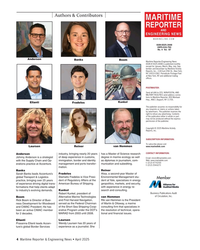 )
April 2025 - Maritime Reporter and Engineering News page: 4
)
April 2025 - Maritime Reporter and Engineering News page: 4, bringing over 25 years dent of Regulatory Affairs at the dent at Yale, specializes in energy of experience driving digital trans- American Bureau of Shipping. geopolitics, markets, and security, formations that help clients adapt with experience in energy re- to industry’s evolving demands.
-
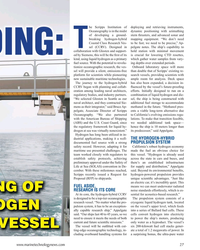 )
March 2025 - Marine Technology Reporter page: 27
)
March 2025 - Marine Technology Reporter page: 27of Scripps ents a viable long-term alternative due Oceanography. “We also partnered to California’s evolving emissions regu- with the American Bureau of Shipping lations. To make that transition feasible, (ABS) and the U.S. Coast Guard, since we needed additional tank space— the regulatory framework
-
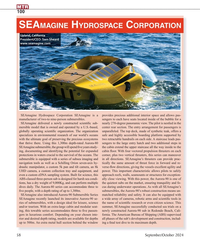 )
September 2024 - Marine Technology Reporter page: 58
)
September 2024 - Marine Technology Reporter page: 58to ? ve passen- newly constructed Aurora-90 sub in Redondo Beach, Cali- gers in luxurious comfort. Depending on your chosen inte- fornia. The American Bureau of Shipping (ABS) supervised rior and desired depth rating, models are available for depths all phases of the sub’s development and construction,
-
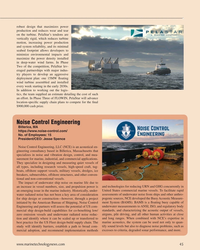 )
September 2024 - Marine Technology Reporter page: 45
)
September 2024 - Marine Technology Reporter page: 45anthro- for ship design or construction—however, through a project pogenic sources, NCE developed the Buoy Acoustic Measure- initiated by the American Bureau of Shipping, Noise Control ment System (BAMS). BAMS is a ? oating buoy capable of Engineering and partners will assess the potential of US com- underwater
-
 )
September 2024 - Maritime Reporter and Engineering News page: 32
)
September 2024 - Maritime Reporter and Engineering News page: 32acquisition of Noise Control Engineering really comes into play. Earlier this year Glosten was awarded an Approval in Prin- ciple (AIP) by the American Bureau of Shipping (ABS) for the design of UC San Diego’s new hydrogen-hybrid Coastal- Class Research Vessel (CCRV). The CCRV will be operated by Scripps
-
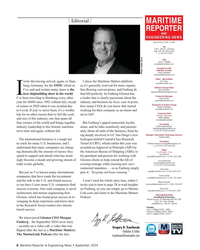 )
September 2024 - Maritime Reporter and Engineering News page: 6
)
September 2024 - Maritime Reporter and Engineering News page: 66320 understand that many companies are chang- awarded an Approval in Principle (AIP) by Sales ing dramatically the amount of money they the American Bureau of Shipping (ABS); to Vice President, Sales Terry Breese spend to support and attend what has seem- his penchant and passion for working with breese@mari
-
 )
May 2024 - Maritime Reporter and Engineering News page: 53
)
May 2024 - Maritime Reporter and Engineering News page: 53Rules and inspection of seawater-lubricated propeller shaft systems in- Guidance for the Survey and Construction of Steel Ships: “In clude the American Bureau of Shipping (ABS), Bureau Veri- recent years, the development of mechanical type sealing de- tas (BV), the China Classi? cation Society (CCS), Det
-
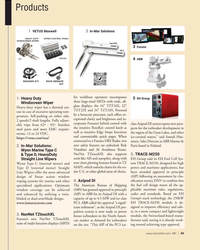 )
April 2024 - Marine News page: 43
)
April 2024 - Marine News page: 43si? cation society DNV to con? rm that 4. Azipod DI wiping systems for marine and other specialized applications. Optimum The American Bureau of Shipping the fuel cell design meets all the ap- window coverage can be achieved (ABS) has granted approval in principle plicable maritime rules
-
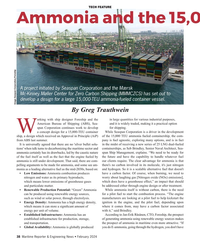 )
February 2024 - Maritime Reporter and Engineering News page: 38
)
February 2024 - Maritime Reporter and Engineering News page: 38Corporation/Foreship By Greg Trauthwein orking with ship designer Foreship and the in large quantities for various industrial purposes, American Bureau of Shipping (ABS), Sea- and it is widely traded, making it a practical option span Corporation continues work to develop for shipping. Wa concept
-
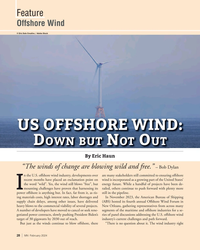 )
February 2024 - Marine News page: 28
)
February 2024 - Marine News page: 28but. In fact, far from it, as ris- still in the pipeline. ing materials costs, high interest rates, labor shortages and In November 2023, the American Bureau of Shipping supply chain delays, among other issues, have delivered (ABS) hosted its fourth annual Offshore Wind Forum in heavy blows to the commercial
-
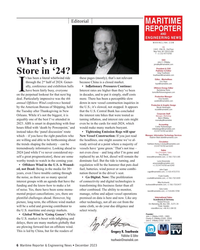 )
December 2023 - Maritime Reporter and Engineering News page: 6
)
December 2023 - Maritime Reporter and Engineering News page: 6.com annual Offshore Wind conference hosted down in new vessel construction inquiries in Production & Graphic Design by the American Bureau of Shipping, held the U.S.; it’s slowed, not stopped. It appears Nicole Ventimiglia [email protected] the Tuesday after Thanksgiving in New
-
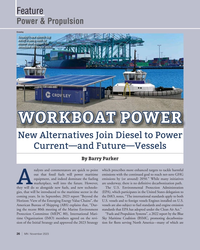 )
November 2023 - Marine News page: 26
)
November 2023 - Marine News page: 26standards apply to both Horizon: View of the Emerging Energy Value Chains”, the U.S. vessels and to foreign vessels Engines installed on U.S. American Bureau of Shipping (ABS) explains that, “Dur- vessels are also subject to fuel standards and engine emission ing the recent 80th meeting of the Marine Environment
-
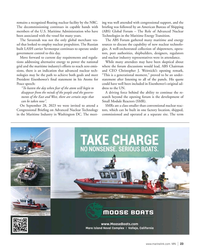 )
November 2023 - Marine News page: 23
)
November 2023 - Marine News page: 23. ing was well attended with congressional support, and the The decommissioning continues in capable hands with brie? ng was followed by an American Bureau of Shipping members of the U.S. Maritime Administration who have (ABS) Global Forum – The Role of Advanced Nuclear been associated with the vessel
-
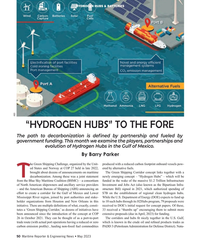 )
May 2023 - Maritime Reporter and Engineering News page: 50
)
May 2023 - Maritime Reporter and Engineering News page: 50of North American shipowners and ancillary service providers Investment and Jobs Act (also known as the Bipartisan Infra- – and the American Bureau of Shipping (ABS) announcing an structure Bill) signed in 2021, which authorized spending of effort to create a corridor for the Gulf of Mexico and
-
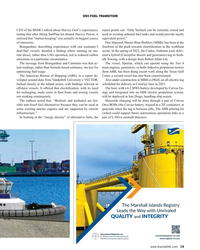 )
April 2023 - Maritime Reporter and Engineering News page: 19
)
April 2023 - Maritime Reporter and Engineering News page: 19, generators, or both- linked to propulsion motors optimizing fuel usage. from ABB, has been doing escort work along the Texas Gulf The American Bureau of Shipping (ABS), in a report de- Coast; a second vessel has also been commissioned. veloped around data from Vanderbilt University’s VECTOR, Also
-
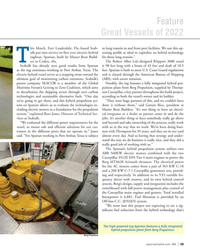 )
November 2022 - Marine News page: 49
)
November 2022 - Marine News page: 49. Spartan is built to meet U.S. Coast Guard regulations electric-hybrid vessel serves as a stepping stone toward the and is classed through the American Bureau of Shipping ultimate goal of minimizing carbon emissions. Seabulk’s (ABS), with escort notation. parent company SEACOR is a member of the Global
-
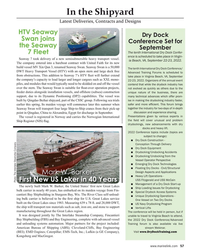 )
August 2022 - Maritime Reporter and Engineering News page: 57
)
August 2022 - Maritime Reporter and Engineering News page: 57Dock Conference/Advanced and unloading systems automation. Major partners for the project included: Training forum is also available via live American Bureau of Shipping (ABS); Cleveland-Cliffs, Bay Engineering stream Webinar. Visit www.DryDockTraining.com (BEI); EMD Engines; Caterpillar; EMS-Tech, Inc
-
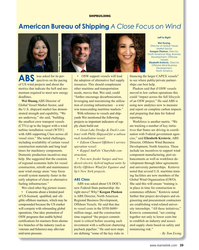 )
August 2022 - Maritime Reporter and Engineering News page: 39
)
August 2022 - Maritime Reporter and Engineering News page: 39SHIPBUILDING American Bureau of Shipping A Close Focus on Wind Left to Right: Wei Huang, Director of Global Vessel Market Sector Keegan Plaskon, Director, North American Reg. Business Development, Offshore Vessels Elizabeth Kretovic, Director, Offshore Wind Business Development, North America Photos
-
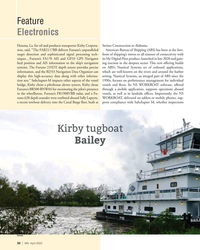 )
April 2022 - Marine News page: 30
)
April 2022 - Marine News page: 30La. for oil and products transporter Kirby Corpora- Steiner Construction in Alabama. tion, said, “The FAR2117BB delivers Furuno’s unparalleled American Bureau of Shipping (ABS) has been at the fore- target detection and sophisticated signal processing tech- front of shipping’s moves to all manner of connectivity
-
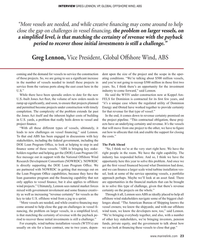 )
February 2022 - Maritime Reporter and Engineering News page: 23
)
February 2022 - Maritime Reporter and Engineering News page: 23. offshore wind stakeholders navigate some of the biggest chal- “More vessels are needed, and while creative ? nancing may lenges ahead. “The American Bureau of Shipping knows the come around to help close the gap on challenges in vessel ? - vessel owners; we know the shipyards; and with our offshore nancing
-
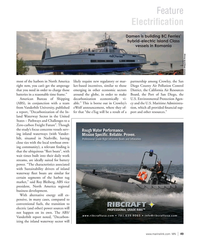 )
November 2021 - Marine News page: 49
)
November 2021 - Marine News page: 49, the California Air Resources batteries in a reasonable time frame.” around the globe, in order to make Board, the Port of San Diego, the American Bureau of Shipping decarbonization economically vi- U.S. Environmental Protection Agen- (ABS), in conjunction with a team able.” This is borne out in Crowley’s
-
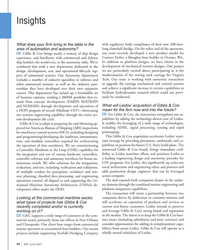 )
June 2021 - Marine News page: 14
)
June 2021 - Marine News page: 14life cycle. It enables the leveraging of a wide range of technologies, Gibbs & Cox is adept at preparing for and obtaining ap- proval for American Bureau of Shipping (ABS) inspections including AI/ML, signal processing, sensing and rapid for machinery control systems (MCS), including designing prototyping
-
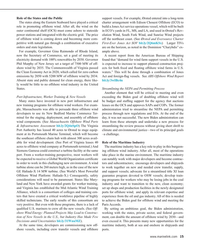 )
April 2021 - Maritime Reporter and Engineering News page: 15
)
April 2021 - Maritime Reporter and Engineering News page: 15, Governor Gina Raimondo of Rhode Island, ample above. now the Secretary of Commerce, set a goal of meeting its A recent report from the American Bureau of Shipping electricity demand with 100% renewables by 2030. Governor found that “demand for wind farm support vessels in the U.S. Phil Murphy of
-
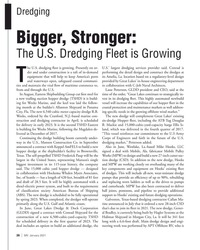 )
January 2021 - Marine News page: 36
)
January 2021 - Marine News page: 36power system, and built to the requirements and cutterheads. MPW has also been contracted to deliver of classi? cation society American Bureau of Shipping ball joints, pontoons, and pipeline to provide additional (ABS). The new dredge is scheduled to be fully operational support to Hooks’
